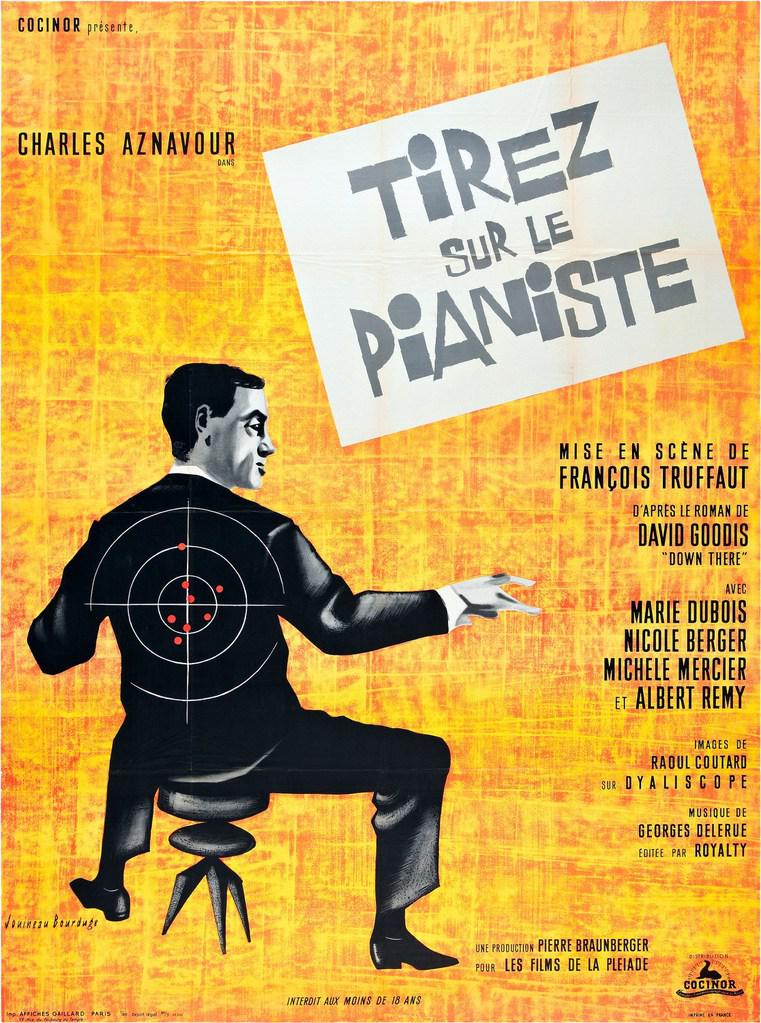Synopsis
A washed-up classical pianist, Charlie Koller/Eduard Saroyan (Charles Aznavour), bottoms out after his wife's suicide — stroking the keys in a Parisian dive bar. The waitress, Lena (Marie Dubois), is falling in love with Charlie, who it turns out is not who he says he is. When his brothers get in trouble with gangsters, Charlie inadvertently gets dragged into the chaos and is forced to rejoin the family he once fled.
Credits
Director (1)
Actors (16)
Production and distribution (3)
- Executive Producer : Les Films de la Pléiade
- Film exports/foreign sales : mk2 films
- French distributors : NEF Diffusion, Cocinor
Full credits (17)
- Adaptation : Marcel Moussy
- Screenwriters : François Truffaut, Marcel Moussy
- Dialogue Writer : François Truffaut
- Director of Photography : Raoul Coutard
- Music Composer : Georges Delerue
- Assistant Director : Robert Bober
- Editors : Claudine Bouché, Cécile Decugis
- Author of original work : David Goodis
- Producer : Pierre Braunberger
- Assistant Operator : Jean-Louis Malige
- Camera Operator : Claude Beausoleil
- Production Manager : Serge Komor
- Continuity supervisor : Suzanne Schiffman
- Additional Music : Félix Leclerc, Boby Lapointe
- Still Photographer : Robert Lachenay
- Continuity Supervisor : Luce Deuss
- Production Manager : Roger Fleytoux
Watch this movie
Watch Shoot the Piano Player in VOD
Technical details
- Type : Feature film
- Genres : Fiction
- Sub-genre : Crime/thriller, Film noir
- Production language : French
- Production country : France (100.0%)
- Original French-language productions : Yes
Box-office & releases
News & awards
Selections (3)
About
Background and writing
Truffaut first read David Goodis's novel in the mid-1950s while shooting Les Mistons when his wife Madeleine Morgenstern read it and recommended it to him. He immediately loved the book's dialogue and poetic tone and showed it to producer Pierre Braunberger, who bought the rights. Truffaut later met Goodis in New York City, where the novelist gave Truffaut a vintage viewfinder from his brief experience as a 2nd Unit Director on a U.S. film.
Truffaut said he made the film in reaction to the success of The 400 Blows, which he considered to be very French. He wanted to show his influence from American films. He later told a reporter that he wanted to shock the audience that had loved The 400 Blows by making a film that would "please the real film nuts and them alone." He previously had several ideas for films about children, but was afraid of repeating himself in his second film. He told a reporter, "I refused to be a prisoner of my own first success. I discarded temptation to renew that success by choosing a "great subject". I turned my back on what everyone waited for and I took my pleasure as my only rule of conduct."
Truffaut began writing the script with Marcel Moussy, who had co-written The 400 Blows. Moussey said that he didn't understand the book and attempted to establish clear social roots for the characters. Truffaut disagreed, wanting to keep the film loose and abstract; Moussey left after a few weeks and Truffaut wrote the script himself. One problem Truffaut had was that he considered the Goodis novel to be too chaste and he decided to make the characters less heroic. The book's main character Charlie is also much stronger in the book and Truffaut called it a Sterling Hayden type. Truffaut decided to go the opposite direction and make the protagonist weaker and the female characters strong. Truffaut was also influenced by French writer Jacques Audiberti while writing the film, such as in his treatment of the character Plyne.[9] Truffaut also used some scenes from other Goodis novels, such as the early scene where Chico bumps into a lamp post and has a conversation with a stranger.
(...)
Full production notes on Wikipedia


























































